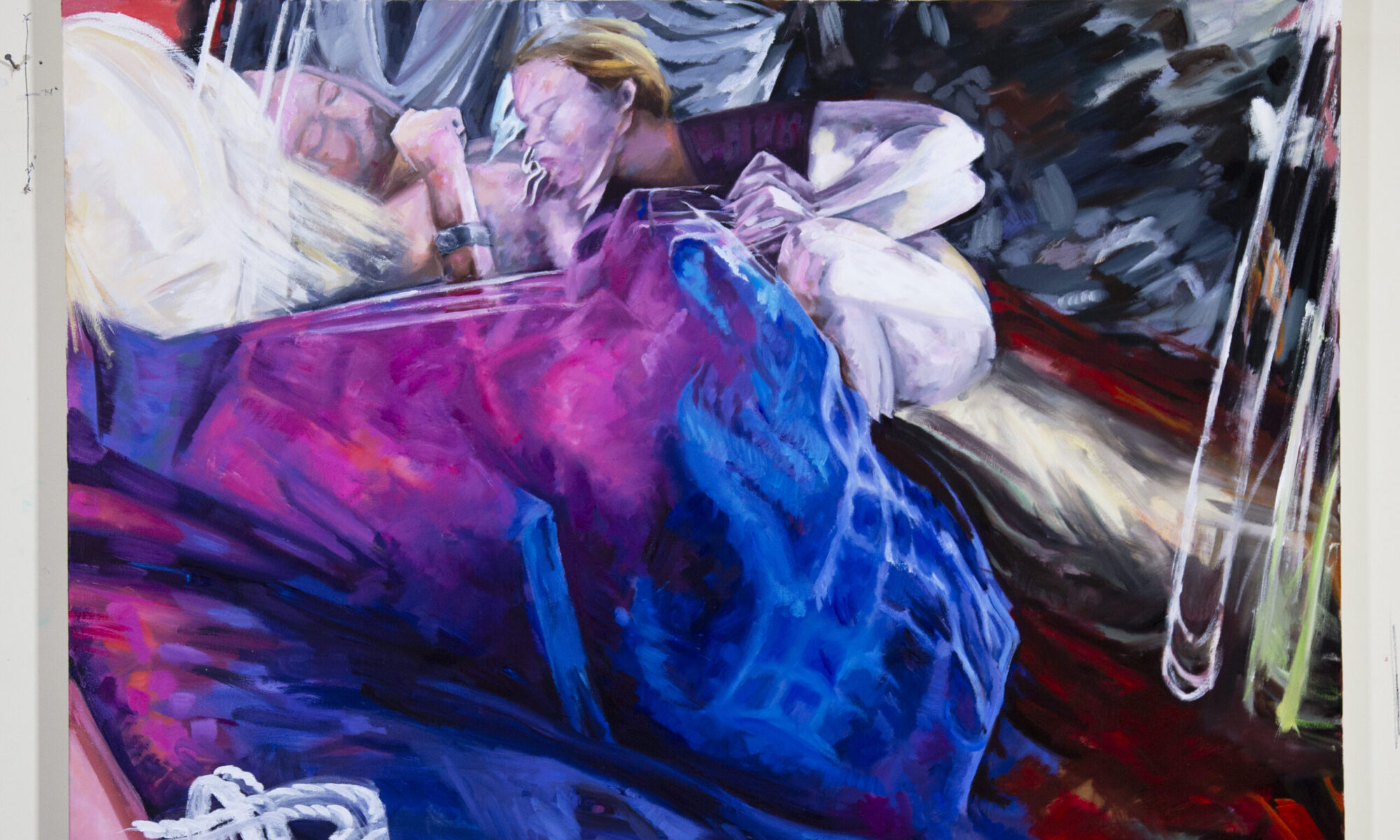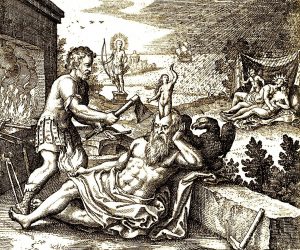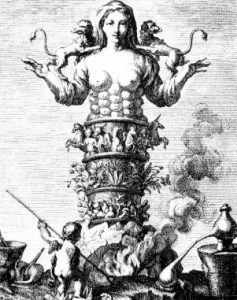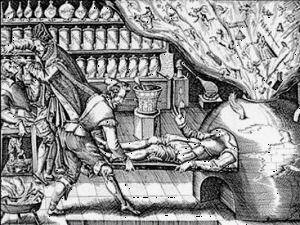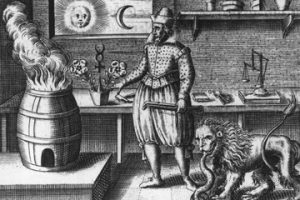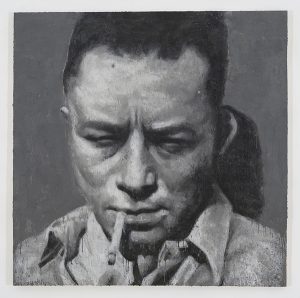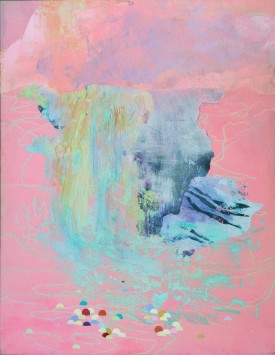Watch me discuss painting, mythology, and spirituality with artist, mystic, and podcaster Alex Coma by a beautiful river in l’Ange Gardien region of Quebec on the Roze Umbra Channel on Youtube. Also available on the Blue Hour podcast. I discuss the symbolism in my paintings, trauma, Tantra, Tarot, the current political climate (this was filmed in the fall of 2024) and more. You can also watch a striking syncronicity transpire live on camera!
For What My Maddened Heart I Most Was Longing: Solo Exhibition
Come join me for my first Montreal solo exhibition this Saturday from 5pm to 7pm, at the Belgo Building in Montreal, #325. I will be sitting the gallery from Wednesday to Saturday, 12-6 until July 15. If you will miss the vernissage, there is an artist talk on Friday, June 29, from 5pm to 7pm where I will discuss my painting practice and erotic works with Liza Sokolovskaya and you can join the discussion as well.
Here is the exhibition text in English and Français suivant.
What For My Maddened Heart I Most Was Longing is an exploration of the erotic in paint spanning 20 years of art making. Mining her unconventional relationships with partners, lovers, and friends, Kara Eckler’s work is autobiographical as well as mystical, and strains of her experiences with spirituality, namely Tantra, witchcraft, and sex magic, permeate many of her works. These works have threads of the sacred running through them as well as the profane. To Eckler, these experiences are not on a polarity, what is considered vulgar and shameful to many can be holy to others, and what is considered estimable and lofty to some, is loathsome to others. In tantric philosophy all of life comes from the divine source, so the world, the body, and sexuality are as sacred as spirit.
Sexuality is a thread that has long intrigued the artist in terms of the relationship between the body and pleasure, the bestial and the celestial. In this exhibition, glimpses of the influence of various sexual subcultures on Eckler’s life and oeuvre can be seen. Questions about the nature of the self are addressed in works which feature doubling of the figure with either doppelgängers or other roles being played, such as the schoolgirl or the harlot. In these ways, Eckler has explored various self-portrayals in her pornography as a muse, but in painting, as the creator. Issues of power, either the exploration of it through sex play, or the loss or gain of it, can be found in various roles ranging from dominant to submissive.
The works in this show touch on Eckler’s interest in looking and seeing, with glimpses of screens and televisions being found. Hints of digital effects or glitches appear, creating a sense of the viewer being unhinged from the normal grasp of reality and time as a fixed thing. Using the self as a starting point of inquiry is a common practice among artists, amateur porn creators, and spiritual practitioners. Beyond the masks our society expects us to wear, do we know ourselves? Who are we when we are not acting for others?
Eckler’s personal relationships have long been blurred, with many of her lovers, friends, and partners featuring in videos with her and often posing for paintings as well. From this culling of content from her work and personal life, she creates scenes to paints, sometimes collaging multiple images together. People may be in our lives for years, or just for one moment, and the artist aims to infuse these paintings with the magic which is felt but perhaps not seen. Her works often give a sense of heightened reality, where our senses are alive, and colours seem brighter, and life burns more luminous than normal.
Quel désir ardent travaillait mon cœur
insensé
Exposition personnelle de Kara Eckler
Quel désir ardent travaillait mon cœur insensé est une exploration de l’érotisme dans la peinture couvrant 20 ans de création artistique. Exploitant ses relations non conventionnelles avec des partenaires, des amants et des amis, l’œuvre de Kara Eckler est à la fois autobiographique et mystique, et des souches de ses expériences avec la spiritualité, à savoir le tantra, la sorcellerie et la magie sexuelle, imprègnent nombre de ses œuvres. Ces œuvres ont des fils du sacré les traversant, ainsi que du profane. Pour Eckler, ces expériences ne sont pas restreintes à une polarité; ce qui est considéré comme vulgaire et honteux pour beaucoup peut être saint pour d’autres, et ce qui est considéré comme estimable et noble pour certains, est répugnant pour d’autres. Dans la philosophie tantrique, toute la vie provient de la source divine, de sorte que le monde, le corps et la sexualité sont aussi sacrés que l’esprit.
La sexualité est un fil qui a longtemps intrigué l’artiste quant au rapport entre le corps et le plaisir, le bestial et le céleste. Cette exposition donne un aperçu de l’influence de diverses sous-cultures sexuelles sur la vie et l’œuvre d’Eckler. Les questions sur la nature de soi sont abordées à travers d’œuvres qui présentent le doublement de la figure avec des sosies ou d’autres rôles joués, comme l’écolière ou la prostituée. De cette manière, Eckler a exploré diverses auto-représentations dans sa pornographie en tant que muse, mais en peinture, en tant que créatrice. Les questions de pouvoir, soit son exploration par le jeu sexuel, soit sa perte ou son gain, peuvent être trouvées dans divers rôles allant de dominant à soumis.
Les œuvres de cette exposition évoquent l’intérêt d’Eckler pour regarder et voir, contenant des aperçus d’écrans et de téléviseurs. Des indices d’effets numériques ou de pépins techniques apparaissent, donnant l’impression que le spectateur est déconnecté de la compréhension normale de la réalité et du temps en tant que chose fixe. L’utilisation de soi comme point de départ de l’enquête est une pratique courante chez les artistes, les créateurs de porno amateur et les praticiens spirituels. Au-delà des masques que notre société nous impose, nous connaissons-nous ? Qui sommes-nous quand nous n’agissons pas pour les autres ?
Les relations personnelles d’Eckler ont longtemps été floues, beaucoup de ses amants, amis et partenaires figurant dans des vidéos avec elle et posant souvent aussi pour des tableaux. À partir de cette sélection de contenu extrait de son oeuvre et de sa vie personnelle, elle crée des scènes à peindre, en assemblant parfois ensemble plusieurs images. Les gens peuvent rester dans nos vies pendant des années, ou juste pour un instant, et l’artiste vise à insuffler à ces peintures la magie ressentie mais peut-être pas aperçue. Ses œuvres évoquent souvent un sentiment de réalité accrue, où nos sens sont vivants, les couleurs semblent plus brillantes, et la vie brûle plus lumineuse que la normale.
Death, Ritual, and Persona
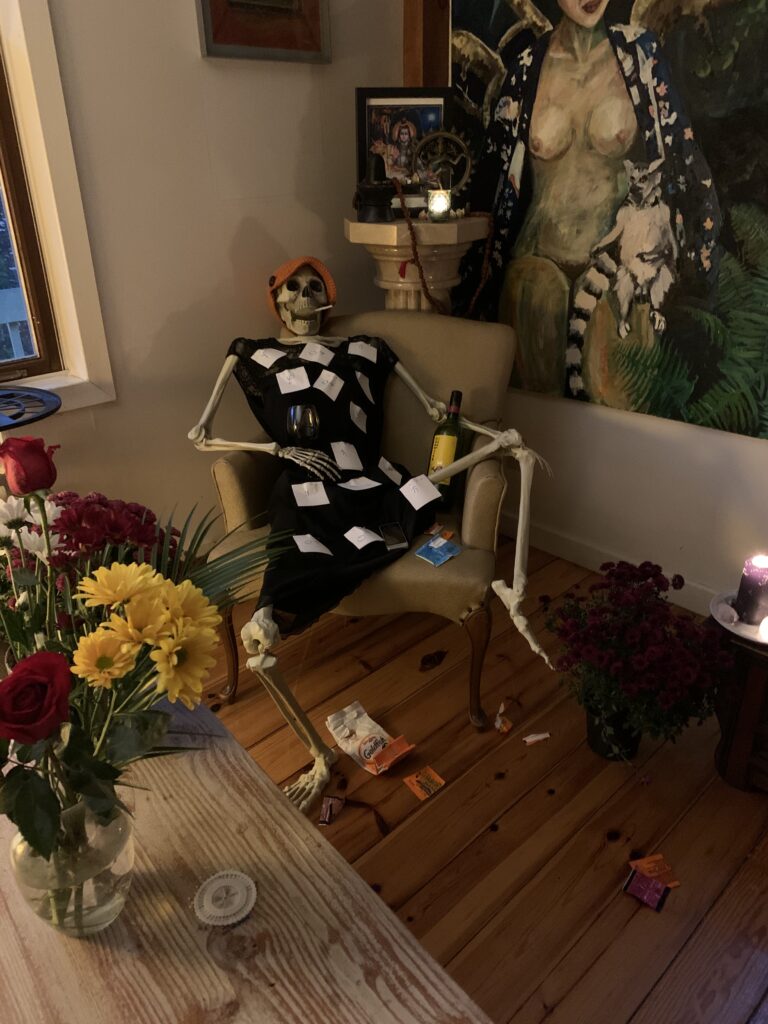
October has always been my favourite month, since it contains both my birthday and Halloween. I’ve loved the intense transformational explosion of the leaves changing colour when, where I grew up in upstate New York, it was always peaking right at the time when I was born. It gave me somewhat of an obsession with the colour red which can be seen in my work. This year, I’ve been studying to become an astrologer, as I’m now 42 and I can’t do porn forever, and I don’t want to pursue other aspects of the industry like being a director and so on. With this crazy economy and my stubbornness about painting whatever suits me, I can’t count on being able to establish a feasible art career either.
To make a long story shorter, this year I decided to try my hand at a Solar Return chart, which is done for the time when the Sun is returning to the same degree of the zodiac it was in when you were born. This is supposed to forecast something about the year to come. I’ve had an incredibly rough couple of years (or decades, let’s face it) and it disturbed me to see a year predicted that was more of the same. Astrologers see the planets as energies or even entities that tie in with mythological figures, such as Mars, Saturn, Jupiter, and so on. Mars, Uranus, Saturn, and Pluto were all lining up to bring me more loss and pain over this year to come, so I also tried something new to me, astrological remediation. This is a magical, ritualistic process that can take almost any form. It is designed to help mitigate the negative influences of the relevant energies, sort of like making a sacrifice to a God.
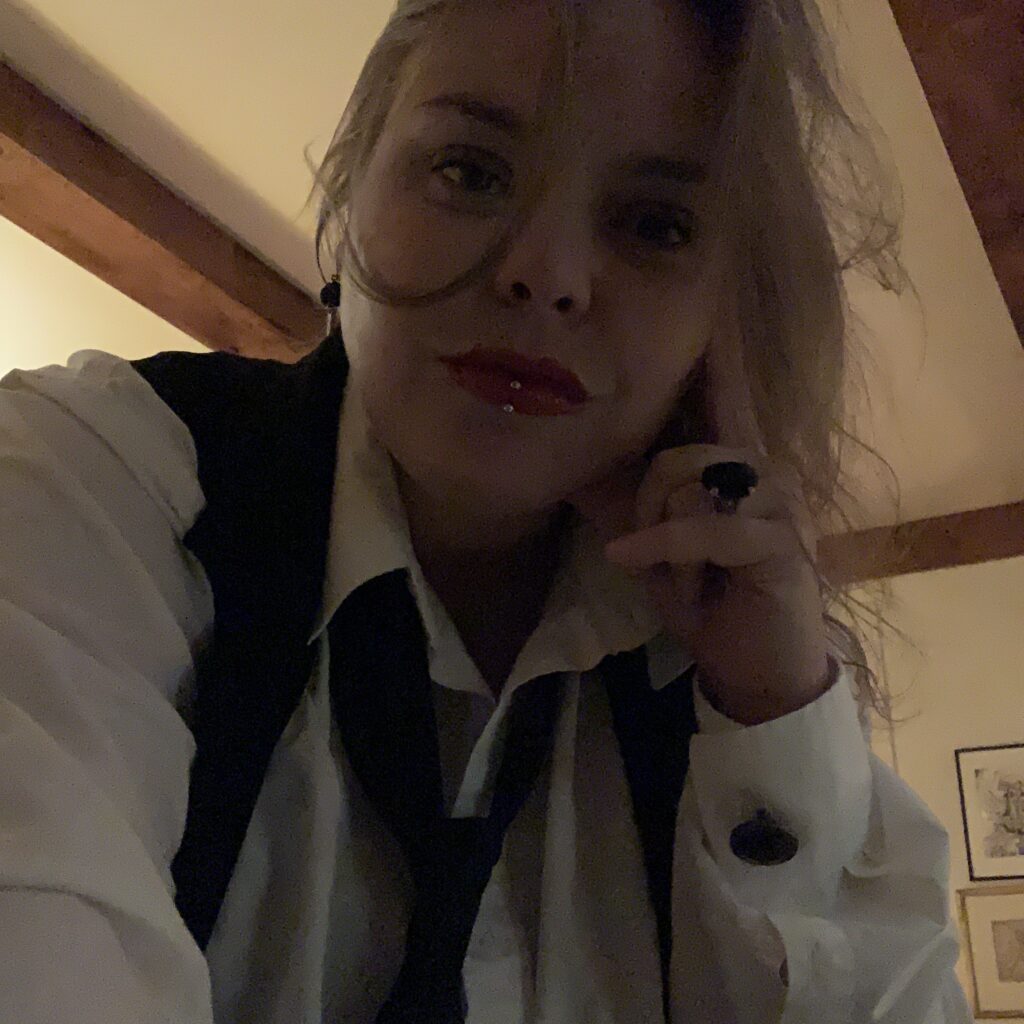
Something in me said, and maybe this is the former goth in me, that it isn’t going to be my birthday, it should be my funeral. The funeral for my old self. The planetary forces are wanting me to let go of everything that I was, and everyone I have loved, it seems, even to the point where I have, under their watch, lost more than one person to sudden death. So be it. Let it all die. In the spirit of Halloween, I dressed a plastic skeleton in my clothes, and pinned intentions related to the relevant planets to the outfit, and had a little fun with it. I placed items relating to my toxic coping mechanisms all around dead me. I got flowers. I lit candles and incense. One of my best and oldest friends and her partner came to visit me and we made it a party, and had a very special weekend.
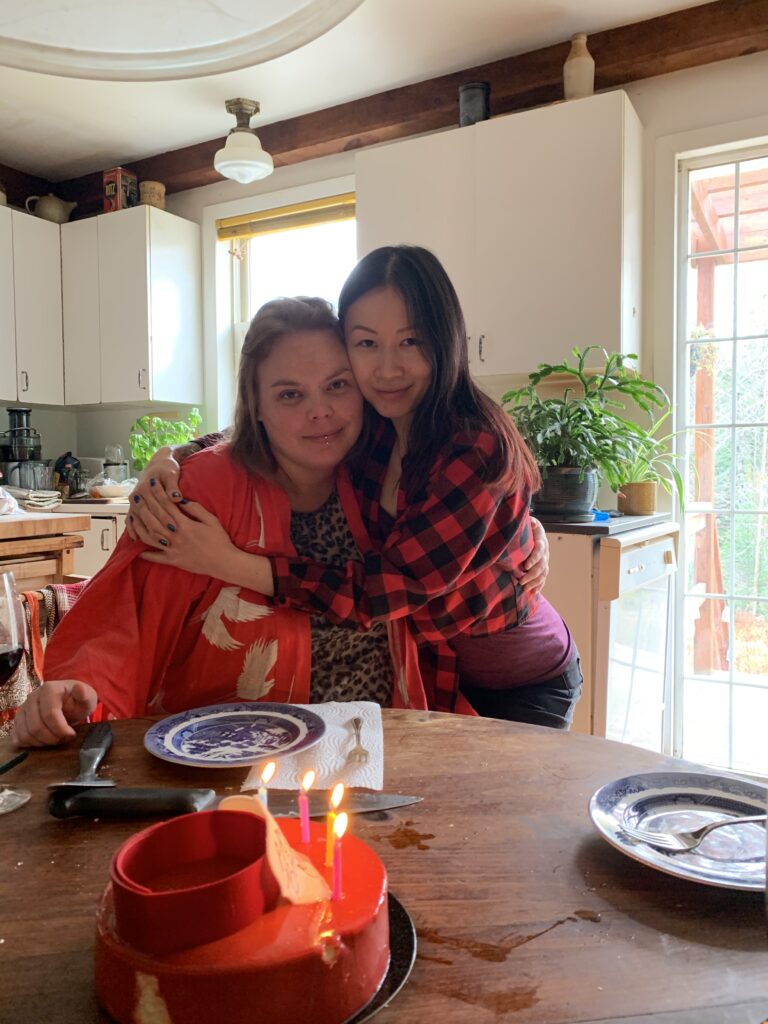
Under the influence of a certain rather magical, healing, perception-altering substance, we finished the ritual together. The way everything worked out was really quite unexpected. They witnessed while I stripped dead me and burned the clothing and intentions on my patio. The selfie above is me dressed in some of my dead husband’s clothes, an impulsive decision but also I was thinking about, for the Mars remediation, how I could use more masculine energy in my being, instead of looking for it in a partner. I lost my husband to last year to a brain hemorrhage, and then my boyfriend this summer to betrayal, I wanted to try internalizing the masculine energy I seemed to be seeking elsewhere. To be my own fucking father figure for a change.
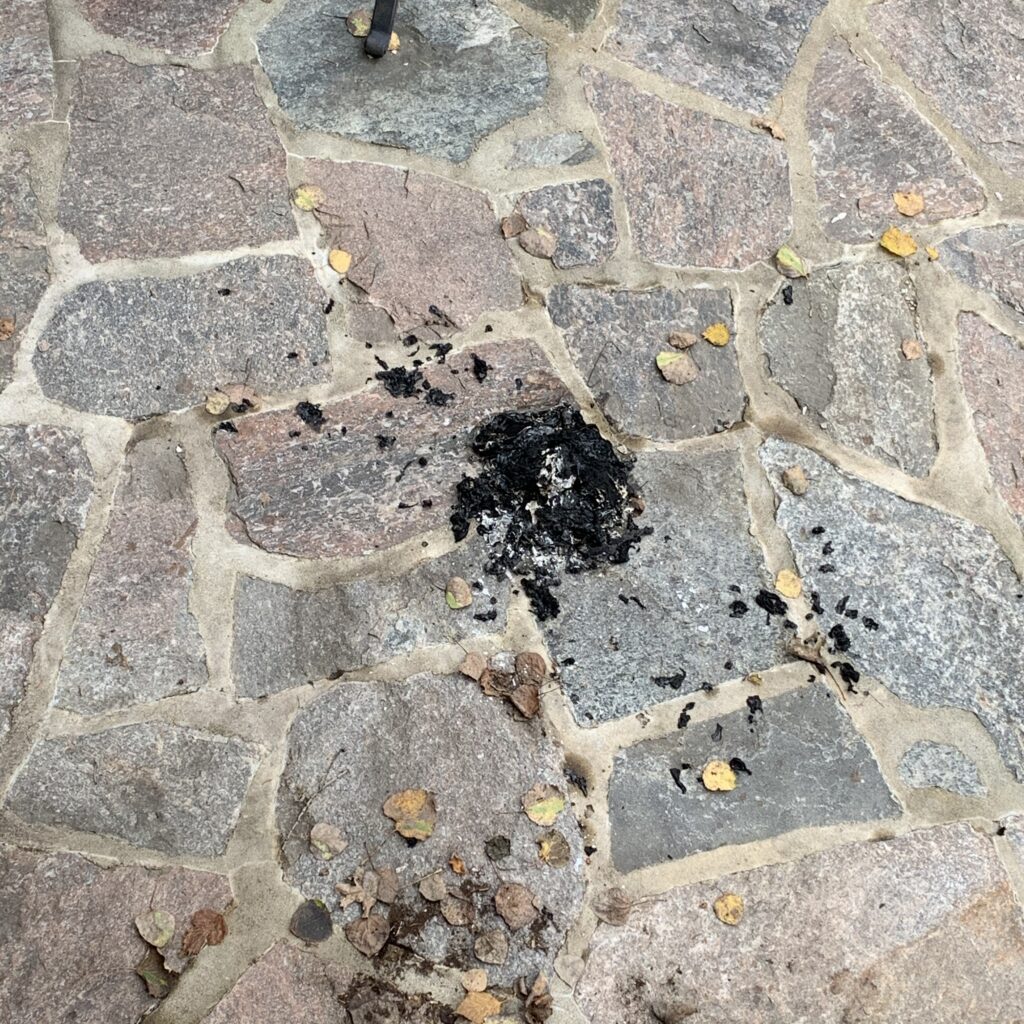
Ritual has long been a part of my life, not really in a formal way, more in a playful and intuitive manner. A method to work with matter and spirit to intentionally mark the passages of life. For me, ritual is much like art. You take various components and materials that have significance, everything included in a ritual is important, similarly to how everything in a painting must be there for a reason. Each part signifies something. Ritual and figurative painting for me are strongly work with symbols and meaning, and are magical in the way they use matter to work with energy and will to create something. Ritual and art also work with an invisible, unseen something. Intuition. Spirit. Vision. Inspiration. The subconscious.
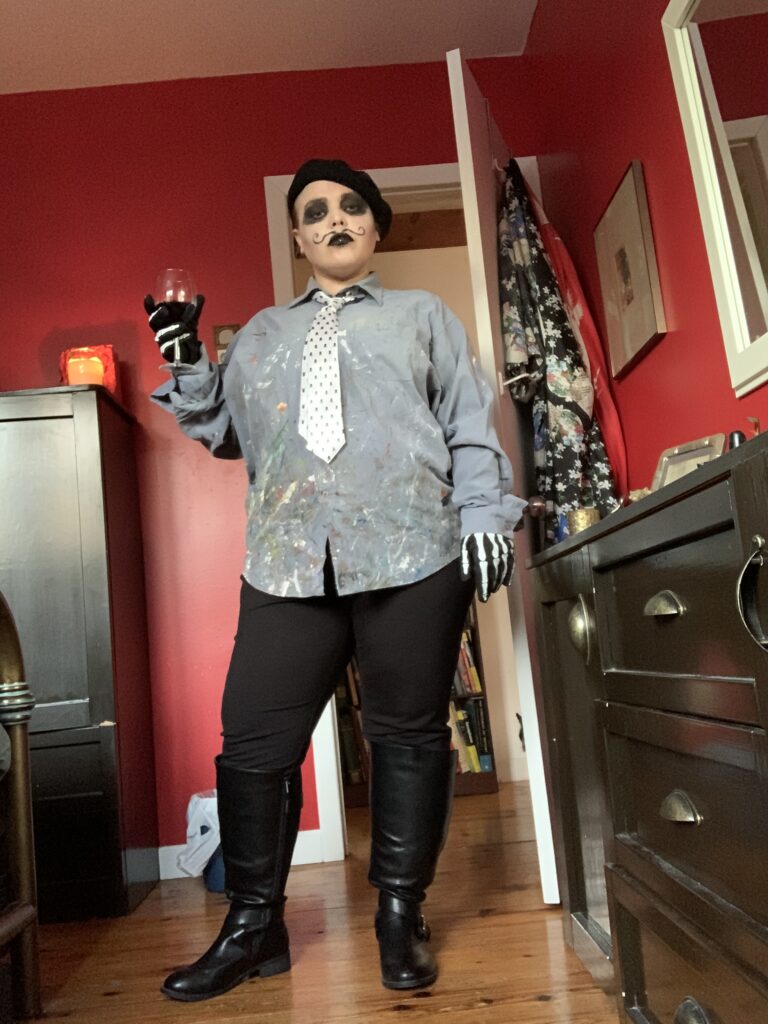
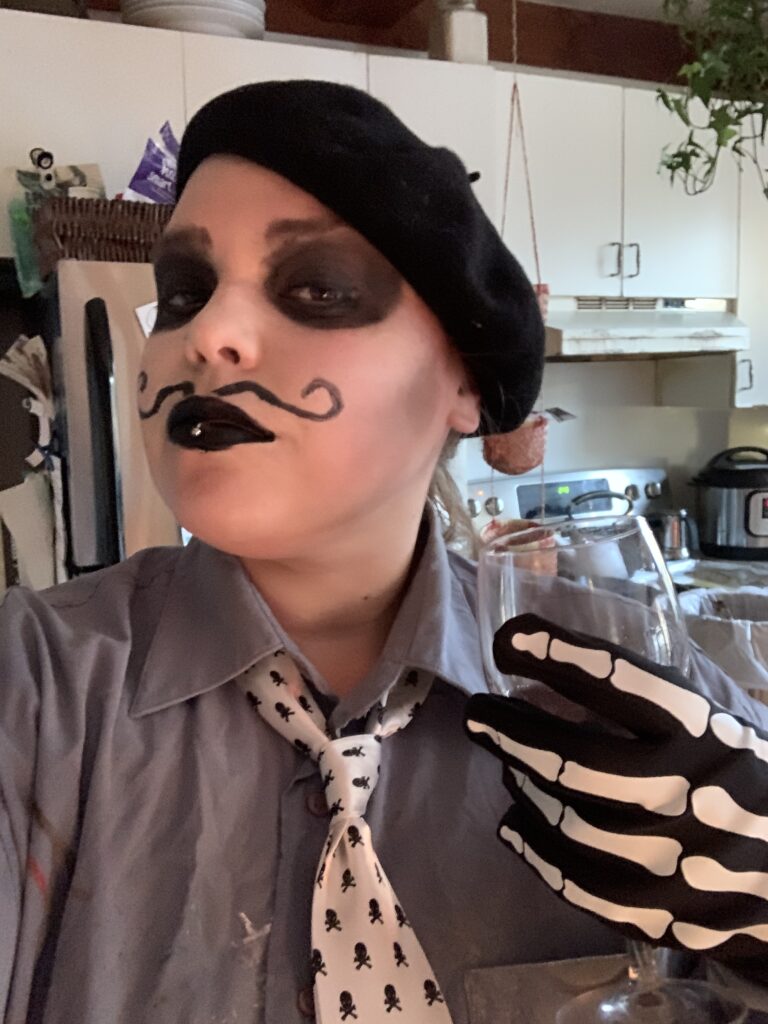
My costume this year was pretty rushed and spontaneous, but in keeping with the theme fo death and pulling in masculine energy, I decided to be a dead white male artist, aka What it Takes to Make it in the Art World. Or maybe I’m a zombie artist come back to life after the pandemic, you decide. I wore some of my husband’s old clothes. This is tongue-in-cheek but also playing a bit with how difficult I’ve found it to make some kind of art career for myself. I realize I’m partly to blame for this, I don’t think anymore it is from any insufficiency in my work, just that my paintings are hard to sell for many reasons and I don’t know where the market is for it or if there is one. I just want to paint what I want to paint, and that happens to be large nudes which are often creepy and overwhelming for people. Not many people have the wall space either. I am working on trying to do more small stuff, however.
Costume has been a part of my art practise for almost the whole time I’ve been painting. Usually I pull on parts of myself, or aspects of a deity if I’m interested in their mythology. One of my early assignments in undergrad in intermediate painting class was to dress up as as aspect of ourselves and paint it. We took the photos in class with coloured lights. I think it made an impression on me on how a painting can be created, starting with the concept, then the creation of the source material, and how different aspects of ourselves can be honoured through art. I dressed up as the weekend goth part of myself. I felt tougher, more insulated, more badass, and it reminded me how what we wear and how we present ourselves can influence how we feel about ourselves and how others see us. This seems like a very basic concept but I was a very naive, sheltered 19 or 20 year-old.
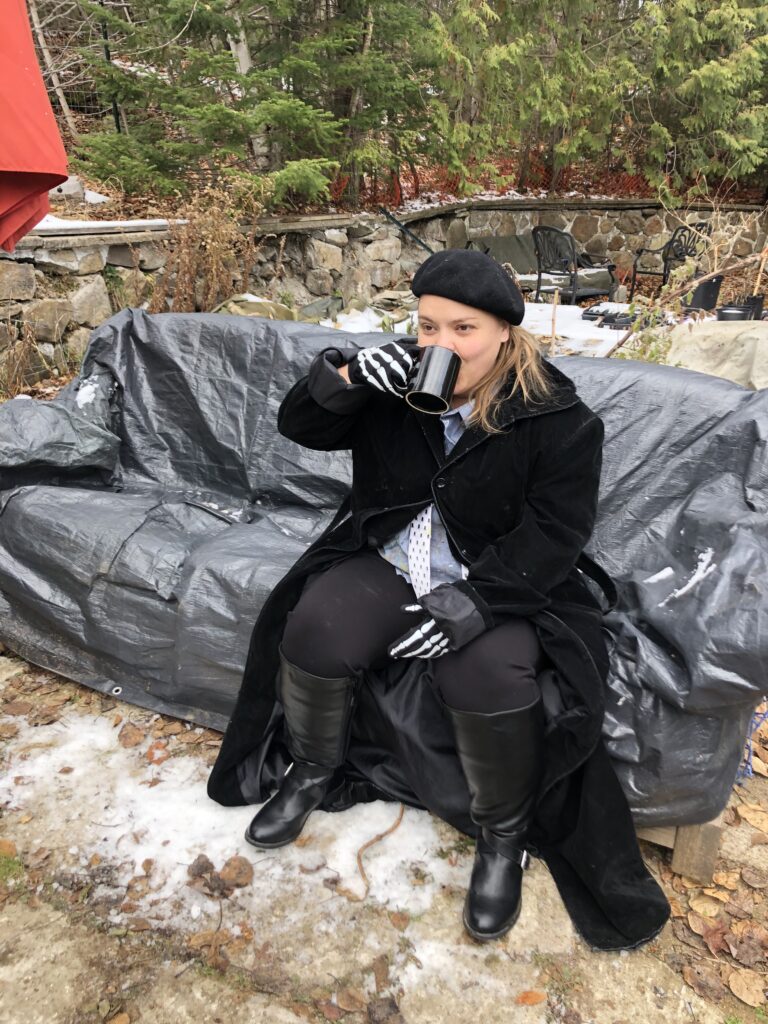
What you see me wearing here is Uday Hussein’s black velvet jacket, as you can see, it is quite large on me, he was 6’5″. My late husband was a writer and war journalist, and he was in Iraq for both wars. I had just met him in 2002 and we had fallen in love only months before he decided to go be one of the few unembedded journalists in this crazy war. I couldn’t stand the idea of him in such danger and had this bad feeling if I wasn’t nearby, he would do something stupid and get himself killed. He went alone at first, but then asked if I would like to come, and against all common sense, I flew into Amman, Jordan. I was an ignorant American, and Jordan was a country I didn’t even know existed before this point. He met me and I stayed in Amman, the first country besides Canada that I had ever been to. I was only 23. Once the war stopped I went to Baghdad with him. But that’s a story for another day. He, along with many other journalists, went to Saddam’s palace. They stole a bunch of things, including some of Saddam Hussein’s notoriously horrible son’s (he was a terrible sadist and an all around evil person by all accounts) designer clothing. This was his rather sinister-looking coat. My husband wrote a funny but controversial article for a newspaper featuring a portrait of himself dressed as an Arab and holding an AK47 I believe, it was called “I am the Thief of Baghdad” (a film reference).
I think I also learned quite a lot about costume and persona not just from my long, long career in pornography, but also from my late husband, who was a theatre star in his youth, helped fundraise for the theatre in Oxford when he was studying there and met Samuel Becket, Richard Burton, Elizabeth Taylor, and Francis Bacon ans others while fundraising. My late husband was also a talented writer of fiction. He was also very talented at making up tall tales, and he was a compulsive liar. Its been extremely difficult and a major mind fuck after his death to discern truth from lies, and I’ve rather given up on that attempt. Does it even matter anymore?
It’s my belief and it has been confirmed by someone who is an authority, that my partner of 17 years had malignant Narcissistic Personality Disorder. I only knew in the last few months of his life. A more benevolent aspect of that disorder is the ability to shapeshift into whatever self you think will get you the most benefit. He was amazing for his ability to travel anywhere and fit into the culture, learn bits of language, get through the most dangerous situations, and charm everyone. So my choice to wear some of his clothing that I kept (which wasn’t much, I donated most of it) may seem a bit morbid or odd, especially considering all the lies and abuse, but part of what I’ve been learning is keep what works, and throw out the rest. A year and a half after his death I’m starting to be able to forgive and release a lot of the trauma and realize that he will always be a part of me, and I accept that. I can wear his clothes. I can live in the house we shared together, even if terrible things happened here. Much of his influence was positive and transformational and contributed hugely to the development of my spiritual practise, my personality, my character, my art, and my understanding of the world. He also inadvertently taught me a lot about what not to put up with in future from people. And how to step away from him, which I did in the years before his death, I was actually trying to separate when he died, but he would make terrible threats and get abusive.
I feel like my birthday ritual at least (too soon to know about the other) has worked surprisingly well as I feel much lighter and happier as if a huge burden of misery and trauma has been lifted from my shoulders, but it could be temporary. For now, I’m enjoying it.
Blackness in Art, the Nigredo and BLM
I wanted to write about something else that was on my to-do list for my next post, but it wouldn’t come. The poignancy, horror and upheaval in the United States during the nationwide protests against police brutality are too much on my mind. So when I considered writing about the portrayal of Black people in my work, I felt motivated to write.
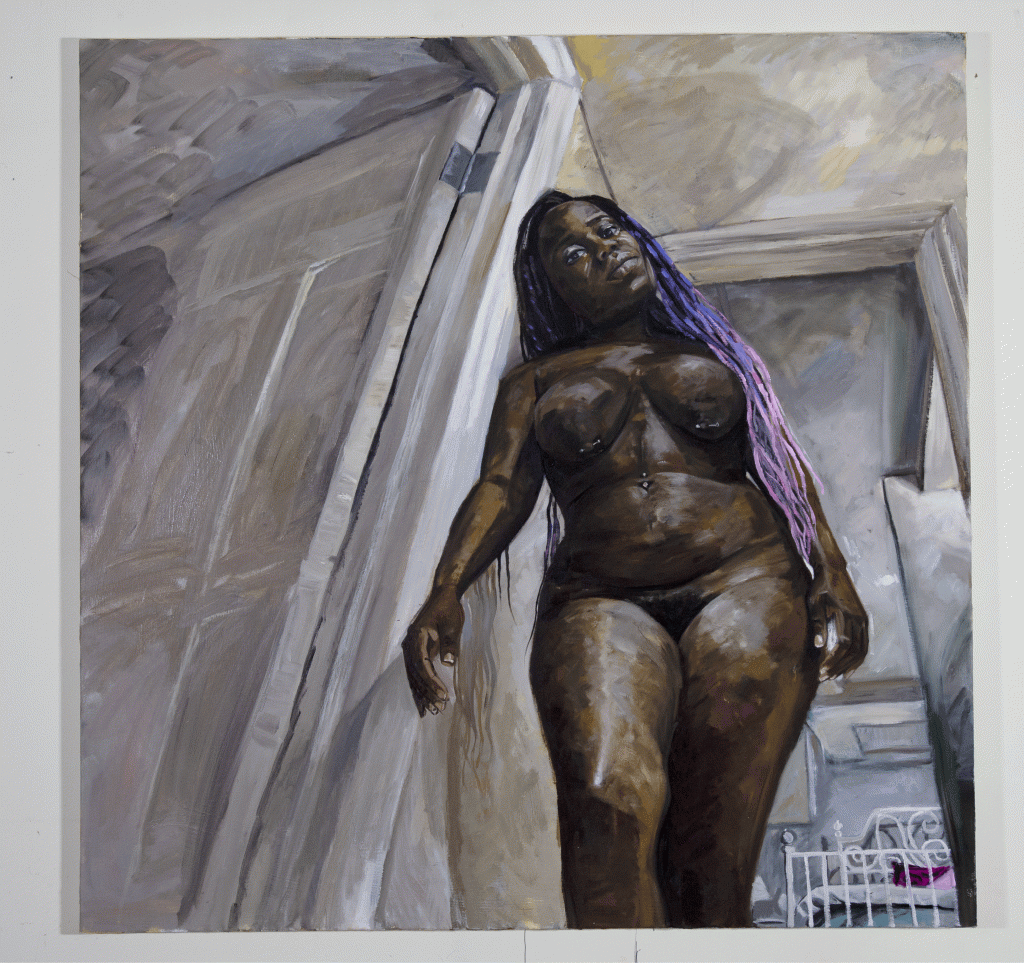
When I started working with alchemy, I studied the various stages of the alchemical process, and a crucial one is called nigredo in Latin. Not a problematic word in itself, it means “the blackening” and refers to the blackening of the alchemical matter prior to it turning to gold. It is a pivotal stage where all is returned to the earth and transmuted, in a sort of death and rebirth. In alchemical engravings of the Renaissance period, artists often used figures to represent mental concepts, and so when I was reinterpreting them for a contemporary audience, I did the same. I painted women in bridal gowns for the albedo, a fireman for the rubedo and I used a Black person for the nigredo. I made the mistake of using images from the internet, as I had recently moved to Quebec and didn’t have any models at the time. In this piece, I was also trying to portray the sacred hermaphrodite, so I painted a Black transwoman. In various studio visits I was told this is problematic, as not only did I not know this person, I didn’t ask permission to paint her. I repainted the image with the permission of a dear friend of mine, Stephanie who I painted several times in recent years. Stephanie was born in Haiti and immigrated to Montreal when she was young. I had her wearing a strap-on to convey the harmony of male and female aspects within the nigredo.
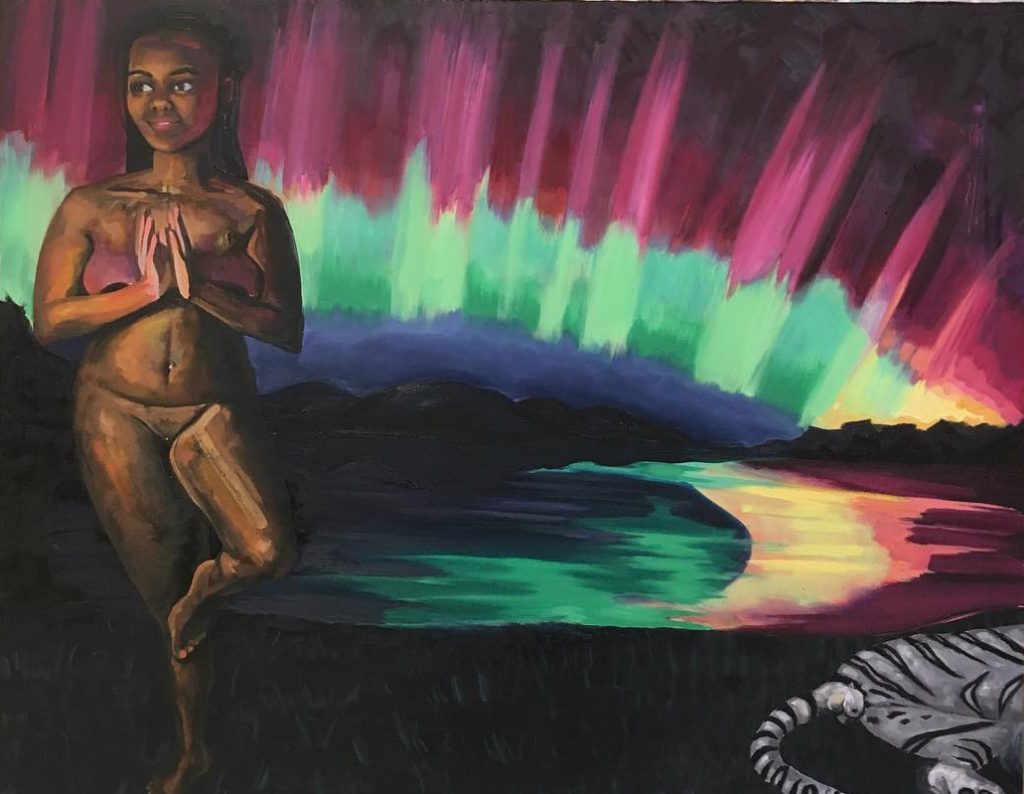
Is it problematic for a white artist to paint a Black person, especially a nude, in an erotic painting? When is it objectifying? When is it regressing to the type of portraying the Other that artists such as Gauguin were famous for? In the studio visits in Montreal, I was also advised to do so by portraying Stephanie in all her humanity and individuality, and I tried my best to do so. It really does look like her, if an alarmed and bizarre version of her. In the painting, she is supposed to be looking so alert because she just woke up, in the mystical sense. The angel in the background (is he Lucifer?) is watching over the process. I wish I had more Black artists as friends, and that at that time I could have asked them for their feedback. I remember when I was taking the photos for the painting of Stephanie she was getting very frustrated because I was anxious about certain poses seeming too submissive or disempowered. She said it is racist that people just can’t see a beautiful woman, they have to see her race first. But I know Black people are not a monolith, they wouldn’t all have the same opinion about a white woman painting them nude.
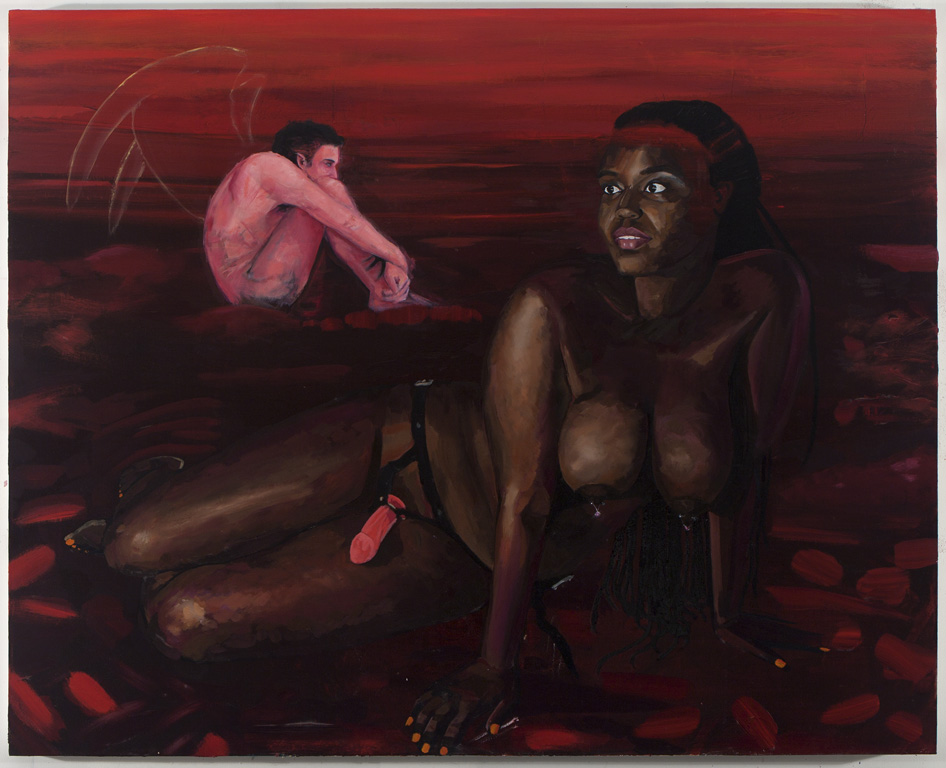
More recently, on sex work Twitter, I had a conversation with a fellow Black performer who was asking herself if she thought she wanted white artists to portray Black people so that they would be represented, or if she thought that they should avoid doing so. The discussion wasn’t conclusive, but the majority believed it needed to be on a case by case basis to see if it was done in an exploitative or respectful way.
My first alchemical painting where the nigredo makes an appearance was a crossover painting between two series. The Bloody Brides and The Alchemical Furnace. Unfortunately, my foolish white privilege didn’t allow me to see what I was doing when I put on blackface for the painting, so it will probably never be shown publicly or sold. I was just thinking of a mask and representing a character who represented that stage of alchemy, at the time I wasn’t thinking of a Black person at all. The blackface aspect of myself is rescuing the bloody bride (also myself), or carrying her body away from a murder scene. I welcome discussions on this topic especially from POC and Black people in particular.
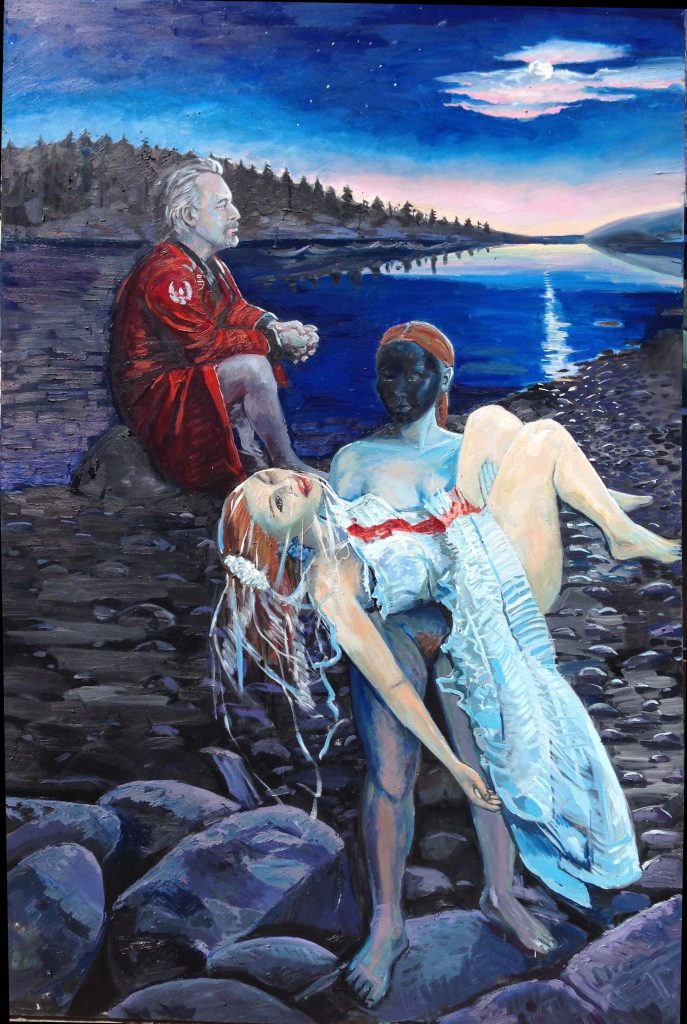
The Alchemical Furnace
These paintings were inspired by the powerful and wonderfully weird alchemical engravings of the 17th century, as well as my interest in Carl Jung’s work on the subject. The act of figurative painting itself is alchemy—mixing pigments with oils and making an image designed to trick the eye and seduce the viewer. Although the bulk of these works use Northern Renaissance engravings as a starting point, their process is contemporary; the application of paint is immediate and expressive, and the colours are hallucinatory and strong. They are painted from a blending of my imagination and found images collaged together with my own photoshoots, largely with intimates and close friends. These works are a dreamscape fraught with the tension of self-transformation, and the sense that the characters themselves are about to wake. The themes of gender, sexuality as well as personal stories also help bring the subject into the 21st century.
To the mystics, alchemy was not about turning base metal into literal gold. It was about transcending the lower nature or using it as a catalyst for the transfiguration of the self. It was about self-realization, or psychological wholeness, as expounded by Jung. The nigredo, or blackening, is a stage of the alchemical process which is about death and decay, the shadow and the dark period which necessarily must come before the light can break, while the rubedo stage, the reddening, is when the impurities begin to be burned away through the heat of fire. In alchemy, Mercury, or the red man, is often present for this part of the process. The albedo, whitening, is when purification occurs—often shown in my work as a bride—and the final stage is citrinitas, the yellowing, when the gold emerges. With this stage comes the alchemist’s gold and goal, but this body of work celebrates the process of life in all stages, the individual’s part in self-creation, and the role of the artist as maker and thaumaturge, or alchemist.
In this body of work, the characters are largely transpersonal and archetypal, often mythical. Feelings of sexual tension and danger are often present in my work, for they represent the powers and forces which drive us to create, the generative power which brings transformation and renewal. These dream-like narratives reveal the various incarnations of the many-faceted self.
My project is a collection of works bringing the ideas behind alchemy into a contemporary light, full of hallucinatory colour and psychological implications. While the women in my paintings are nude, they are not sex objects, far from it, they are powerful, self-actualized women in process of transformation. They are open, free, growing and in tune with their sexuality, or whatever they wish to express. For me, in painting the purpose is the process, the joy of creation and discovery, traces of energy and life. It can be as simple as that. I want to create paintings that are as mysterious and puzzling as life is. My wish is for the viewer to be intrigued by the images, to enjoy their mystery and to potentially revel in seeing new aspects to them as long as they care to look.
The Far Off Blue Places: Anjuli Rathod & Vanessa Brown
Anjuli Rathod and Vanessa Brown are emerging artists whose work interplays oneirically in The Far Off Blue Places at Projet Pangée, where the viewer becomes a shadow character from the works themselves, walking among pieces rendered alternately in two and three dimensions. Both artists present strong, whimsical, dreamy work that one can return to again and again to discover new elements and interpretations. The imagery and colour in these paintings and sculptures rhymes and riffs in a harmonious manner without feeling forced. The works in this exhibit are markedly influenced by surrealism yet also brings in contemporary concerns and display a love of materials as well as the symbolic.
Read the full article at The Belgo Report
Christian Messier: La Forêt s’en vient II
Christian Messier’s exhibition, la Forêt s’en vient II, or The Forest is Coming II, is a presentation of an exhibition organized by Galerie Verticale that was held in the new lobby of Salle André-Mathieu in Laval, which is intended to “professionalize their visual arts presentation”. This series of works was removed amidst some controversy earlier this year due to several complaints from the public after visiting the hall for a Bruno Pelletier show. The organizers demanded that six paintings be removed, to which, after a lengthy period of debate, Messier responded that the entire show must be taken down, asserting by an all or nothing policy that they are a whole not to be divided. These works on view at Galerie Laroche Joncas were displayed as they were intended to be exhibited, uncensored. The theme of proposals from which his work was chosen for the show in Laval was “the strange, humour and the grotesque”, presumably a response to the frequent stand-up comedy shows performed at the hall. Ironically, comedy shows gain nearly all of their popularity through bawdy humour, taboo, and controversial topics, but apparently, some nudity in the hall on the way to the show was too much for some visitors to bear, or at least for the Pelletier crowd. The six paintings which were censored did not feature simple classical nudity, as some of Messier’s works in this series resemble, such as the canvas of figures cavorting in an elegant circle la Matisse’s dancers. Instead, it was the works which displayed any semblance of sexuality, through the groping of breasts, implied orgies or sexual activity that the ones which stimulated complaint.
